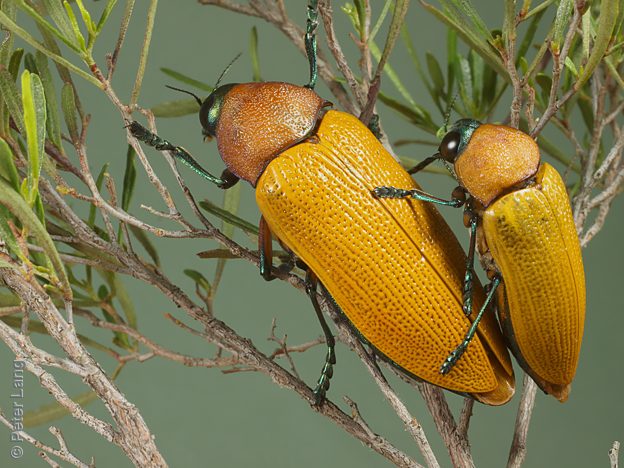
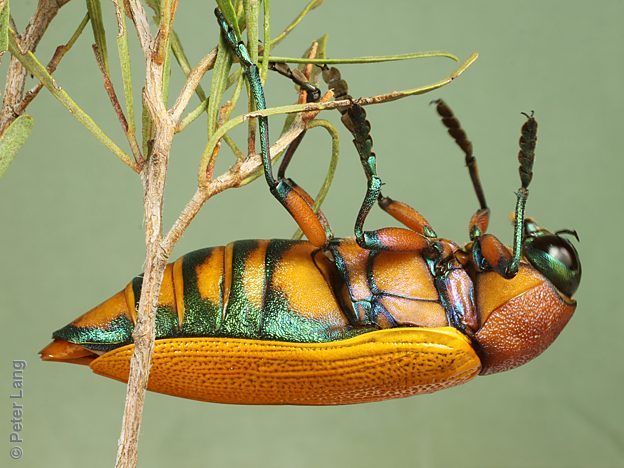

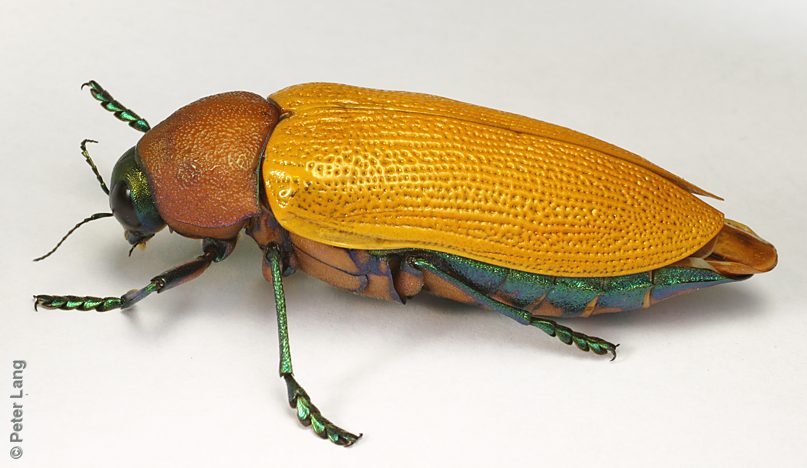
size¹:
×
15.9 mm




| male | female | |||||
|---|---|---|---|---|---|---|
| L1 | 40.6 | 31.5 – 47.7 | n = 55 | 49.3 | 42 – 56 | n = 6 |
| L2 | 40.6 | 31.5 – 47.7 | n = 55 | 49.2 | 42 – 55.8 | n = 6 |
| W | 15.5 | 12.6 – 18.1 | n = 55 | 19.8 | 16.9 – 22.9 | n = 6 |
| Legend | L1 | length from clypeus/frons to elytral apex (mean, range, sample size) |
| L2 | length from anterior of edge of eyes to elytral apex | |
| W | maximum width with elytra fully closed |
This distinctive genus is named for its superficial resemblance to the African Buprestid genus Julodis. The adults are short-lived and often appear in large numbers in mallee areas of SA from late November to mid-December.
Bellamy & Weir 2008 reinstated Julodimorpha saundersii, dividing the genus into a western and eastern species, although the geographical boundary between them was not precisely established. The western species, J. saundersii, at least, is famous for the habit of males congregating on and attempting to mate with discarded stubbie beer bottles which have a similar colouring and stippled texture to the beetles.
There are many SA Museum specimens of this species that have not yet had their data captured.
| Legend | P.J.Lang collection vouchered records | |
| other private collection or museum specimens, or sightings |
|
|
|
|
|
|
|
|
|
|
|
|
|
||||||||||||||||||||||||||||||||||||||||||||||||
|
|
|
|
|
|
|
|
|
|
|
|
|
||||||||||||||||||||||||||||||||||||||||||||||||
| Jul | Aug | Sep | Oct | Nov | Dec | Jan | Feb | Mar | Apr | May | Jun |
| Legend | live emerged adults, count > median value of 8 per quarter month | |
| live emerged adults, count <= median value of 8 | ||
| live non-emerged adults only, for that quarter month | ||
12 | number of active beetles for that quarter month |
| beetles | sites | SA regions¹ | family | position on host plant | |||
| Eucalyptus sp. | 8 | 3 | EP, MU | M | |||
| Hysterobaeckea behrii | 5 | 3 | SE | M | |||
| Dodonaea viscosa ssp. angustissima | 2 | 1 | EP | S | |||
| Citrus sp. | 1 | 1 | MU | R |
| Legend | beetles | count of beetles collected from, or sighted on, host plant taxon |
| sites | count of major sites (unique 10 km grid cells +/- some distinct approximate localities) | |
| Plant names in green are hyperlinked to a matching host species page with plant photos. | ||
| Code | beetles | % | host plant taxa | |
| M | Myrtaceae | 13 | 81% | 2 |
| S | Sapindaceae | 2 | 13% | 1 |
| R | Rutaceae | 1 | 6% | 1 |
| position | beetles | sites | ||
| on flowering plant | 5 | 3 | ||
| on foliage or non-flowering plant | 3 | 2 | ||
| on plant (unspecified) | 1 | 1 | ||
| other | ||||
| hovering over | 5 | 1 | ||
| on trunk | 2 | 1 | ||
| colour | beetles | sites | SA regions¹ | |
| yellow | 169 | 3 | EP, SE | |
| red | 160 | 3 | EP, MU | |
| orange | 24 | 3 | SE |

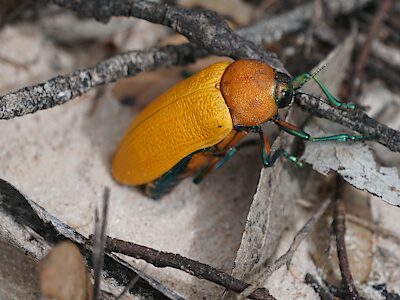
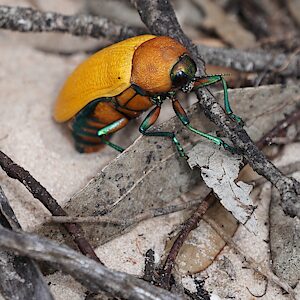
Larvae are believed to feed on roots and Hawkeswood & Peterson 1982 cite a WA collection of a beetle ovipositing 2.5 cm below the ground near the base of a Calothamnus shrub. Bílý, Volkovitsh & Peterson 2013 describe a larva presumed to be of the very similar Julodimorpha saundersi from WA found in a frass-lined chamber in sand 40 cm below the surface and associated with a plant root that had been chewed where it adjoined the chamber.
| ¹ Legend | regions | SA State Herbarium regions (map) EA: Eastern, EP: Eyre Peninsula, FR: Flinders Ranges, GT: Gairdner-Torrens, KI: Kangaroo Island, LE: Lake Eyre, MU: Murray, NL: Northern Lofty, NU: Nullarbor, NW: North-Western, SE: South-Eastern, SL: Southern Lofty, YP: Yorke Peninsula |
| size | The ellipse is the correct size when printed, indicative on a desktop screen, and likely to be wrong on a mobile device. |